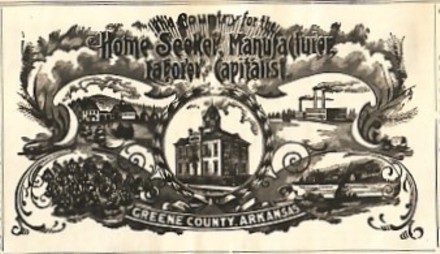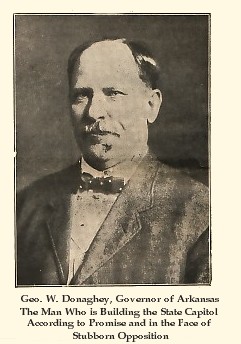Shipping facilities are fast becoming first class and there are many canning factories located in this section of the state.
There are still many thousands of acres of good orchard land on Crowley's Ridge that can be had at a reasonable price, and a few crops of the fruit grown upon the land will pay for the same. We desire more of this land in orchards instead of cotton fields and in order to bring about the change, it is necessary to bring people who know how to raise something besides cotton.
One decided advantage our fruit growers have over those in northern climates is that we can deliver berries and fruits in the Chicago market before the same fruits are in bloom in many sections of the country. Paragould has a large up-to-date canning factory that affords a ready market for the surplus fruits and berries, tomatoes and some grains.
(The factory did not run last season on account of some financial trouble but is a good investment for some man who under-stands the business.--Ed.)
A few farmers who have gone into the fruit and berry business have even with a limited knowledge of the business made more money to the acre on the ground cultivated than the same farmers could on the same lands after a life time of experience in growing the fleecy staple. With a thorough knowledge of the fruit growing business, together with a familiarity of the markets for the products of the orchard there is no telling the possibilities of a fruit farm in Greene county.
~~~~~~~~~~~~~~~~~~~~
Truck Growing and Poultry
Truck growing and gardening are profitable occupations that are
only partially represented among the indus-tries of this section.
The long open season and the accessibility to
good markets assure a large profit to those engaging in either of these
pursuits. Chickens find a ready market in Para-gould
and eggs are always scarce at a top-of-the market price, these conditions offering a large return to anyone engag-ing in the
poultry or trucking business.
Of the vegetables, sweet and Irish
potatoes lead, two crops of the latter can be raised on the same land in
one season, the yield being about two hundred bush-els per acre.
When only one crop is desired and the potatoes are
allowed to fully mature, the yield is increased about one
hundred bushels more to the acre.
Melons, onions, parsnips, turnips and cabbage can be produced in as fine quality and in as great a quantity as any-where in the United
States. All kinds of vegetables are ready to put on the market long
before the gardens are made in many northern and eastern states.
Peanuts and tobacco are small crops with some of our
citizens and find a cash market on the streets
of Paragould at any and all seasons of the year. It is believed the
tobacco grown here is as fine as that grown in Kentucky or Tennessee,
and the yield is about one thousand pounds per acre.
~~~~~~~~~~~~~~~~~~~~~


~~~~~~~~~~~~~~~~~~~~~~~~~~~~~~~~
Live Stock
This country is well adapted to the successful raising of horses,
mules, cattle, sheep, hogs and all kinds of live stock. We have no stock
law in the country, so all stock can run out on the commons or range all
the year around, and require little feed or attention. But they do
better if provided with some food and shelter during January and
February.
The southern boundary line of the county serves as the cattle
quarantine line, it having been re-established in the year 1908
after the government expert reported favorably on the Texas
fever tick troubles and this is of course and advantage to us
over the counties lying south of Greene county.
There are large numbers of fine stock in the
county especially of mules, cattle, hogs and the like, and persons who
have brought fine stock here from Ohio or Indiana.
Illinois or Kentucky have experienced no difficulty so far as the
climate and water is concerned. Therefore
there is no danger in bringing your stock with you in coming to
this section. Good farms suitable for stock raising
and convenient to range can be had at marvelously low prices.
~~~~~~~~~~~~~~~~~
Timber
The greater portion of the lands in Greene county have been
cut over for the larger white oak timber, but it is hardly fair
to say that it has been taken off for only the very largest
trees were cut, and this many years ago, in most instances.
There are yet, several thousand acres of virgin timber lands
in the county, although the lumber has brought many thousands
of dollars to the county, and will continue to do so for many
years to come. Saw mills and all kinds of lumber manufacturing concerns thrived thru the general panic and new fields
of timber lands are constantly being opened.
~~~~~~~~~~~~~~~~~
Game and Fish
Hunting and fishing are fine sports here, and the recreations
enjoyed by the lovers of sport in Greene county, for when
they start hunting or angling for the finny tribe they have
every reason to believe their efforts will be crowned
with success.
There is very little hunting or fishing for gain in this
country, but both are engaged in purely for sport and
recreation. Our people are too busy following more
lucrative business, and resort to hunting and fishing solely
for pastime. Fishing parties are common among the young
people and an occasional fish-fry by old-timers occurs
early in the spring or late in the fall. Perch, cat, pike and
black bass abound in all our waters. Wild game is abundant,
especially deer, turkey, duck, raccoon, opossum, squirrel
and quail or partridges. We have game laws to protect
most of our wild animals and fish during part of the year
from the wanton destruction of fishing parties from other states. During
the late fall and winter season hunting parties organize here and they spend a month or
six weeks in the timber, camping out, and never fail to
return with all the game desired.
~~~~~~~~~~~~~~~~~~~~~~~~
A Common Error Corrected
There is a general belief that a greater part of the
eastern section of Arkansas is under water, or subject to frequent
over-flow. Those who are familiar with conditions as they really exist
in the state need not be told this is not the case. While it is an
indisputable fact that the railways entering
Arkansas do show the state to a great disadvantage in
this respect, especially those entering Arkansas
at Memphis, the ancient gateway to the state, yet
there are sixteen states in the Union having a greater number of square
miles of water surface than Arkansas and ninety percent of
our water surface is navigable rivers. It
should also be remembered that the Mississippi river which
is the eastern boundary of the state, traverses the entire length of
Arkansas, and the Father of Waters and
other navigable streams add materially to the water surface as they do
the shipping facilities of the people.
overflow of the Mississippi river, as it is situated high and dry upon Crowley's Ridge, a highland extending northward across the eastern end of the state.
~~~~~~~~~~~~~
Climatic Conditions
Zero weather is not entirely unknown in Arkansas, especially in the extreme north-western or mountainous section of the state, but this temperature is so rarely registered even during the severest weather in January and February that it is regarded as an extremely bitter condition.
The temperature at the center line of the state averages forty-three for the winder and eight for the summer. The state lies between thirty-three and thirty-seven north latitude and eighty-nine and ninety-five west longitude, insuring a mild climate
and an even temperature.
Sultry hot nights during the summer months are few, a delightful summer breeze from the Gulf of Mexico prevailing during the greater part of the day.
Sunstroke or prostrations from heat are unknown here although the summers are long and the outdoor season lasts nearly all the year around.
The average date of the last killing frost in the spring is March 22nd, and the earli-est in the fall is November the 8th.
~~~~~~~~~~~~~~~~~~~~~~
Soil
Every country has its good and bad soil, and Arkansas is no exception, but we do claim that our county has as little of the bad, and as much of the best as any section of the United States. The ridge land, usually thin and worthless, is in
Greene county rich productive, being particularly adapted to the growing of fruits, berries, grapes and live stock.
The rough hill lands in sections of the state are of little value, being too thin for agricultural purposes, are rich in valuable clays, marble, coal, lead, zinc and even silver and gold are known to exist in paying quantities in the mountainous
section. Only in recent years has the attention of the world been attracted to our diamond fields, which are said to be of the richest in the world, and the pearls of Black river and other streams of the state are the marvel of mankind.
The white, or buckshot land of the state has until lately been considered the poor-est land in Arkansas but some surprising results have been obtained by careful cultivation and since it has been demon-strated that rice of the very finest quality can be grown here, this kind of land has come into great demand, as it will produce from fifty to seventy bushels of the cereal to the acre, and has advanced from less than five to more than fifty dollars an acre.
In the river and creek bottoms is found the sandy loam, and the black sandy soil, the natural home of King Cotton, but which will grow anything, excepting, of course, tropical fruits.
~~~~~~~~~~~~~~~~~~~~~~~~
